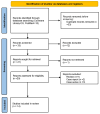The Role of Dynamic Computed Tomography Angiography in Endoleak Detection and Classification After Endovascular Aneurysm Repair: A Comprehensive Review
- PMID: 39941300
- PMCID: PMC11817272
- DOI: 10.3390/diagnostics15030370
The Role of Dynamic Computed Tomography Angiography in Endoleak Detection and Classification After Endovascular Aneurysm Repair: A Comprehensive Review
Abstract
Backgroud: The use of dynamic computed tomography angiography (dCTA) for the detection of endoleaks in patients who underwent endovascular repair of abdominal aortic aneurysms is gaining interest. This study aims to provide an overview of the current applications of dCTA technologies in vascular surgery. Methods: We performed a comprehensive review by searching in the PubMed database and Cochrane Library (last search: 1 November 2024). We included studies considering endoleak investigation after endovascular aneurysm repair (EVAR). We included papers that reported the outcome of applications of dCTA, excluding case reports or very limited case series (≤4). Finally, 14 studies regarding 377 computed tomography angiographies (CTA) were included and evaluated. Results: Persistent perfusion of the aneurysm sac is the most common complication after EVAR. Imaging-based surveillance post-EVAR is essential with the aim of early detection, characterization, and localization of endoleaks to guide therapeutic intervention or follow-up. dCTA detected 36 type I endoleaks versus 16 identified with standard CTA and 138 versus 95 type II endoleaks. Conclusions: The emergence of dCTA offers a promising solution through enhanced temporal resolution, allowing the visualization of real-time flow dynamics within the aneurysmal sac essential to establishing endoleak treatment or post-EVAR follow-up.
Keywords: 4D; EVAR; dynamic computed tomography; endoleak; four-dimensional computed tomography.
Conflict of interest statement
The authors declared no potential conflicts of interest with respect to the research, authorship, and/or publication of this article.
Figures


References
-
- Antoniou G.A., Antoniou S.A., Torella F. Editor’s Choice–Endovascular vs. Open Repair for Abdominal Aortic Aneurysm: Systematic Review and Meta-Analysis of Updated Peri-Operative and Long Term Data of Randomised Controlled Trials. Eur. J. Vasc. Endovasc. Surg. 2020;59:385–397. doi: 10.1016/j.ejvs.2019.11.030. - DOI - PubMed
-
- Loufopoulos G., Tasoudis P., Koudounas G., Zoupas I., Madouros N., Sá M.P., Karkos C.D., Giannopoulos S., Tassiopoulos A.K. Long-Term Outcomes of Open Versus Endovascular Treatment for Abdominal Aortic Aneurysm: Systematic Review and Meta-Analysis with Reconstructed Time-to-Event Data. J. Endovasc. Ther. 2023;19:1–11. doi: 10.1177/15266028231204805. - DOI - PubMed
Publication types
LinkOut - more resources
Full Text Sources

